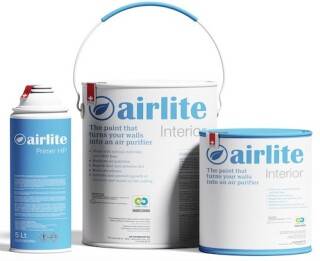When we think about home appliances, our minds often jump to the usual suspects—refrigerators, ovens, dishwashers, washing machines, and vacuum cleaners. These are the workhorses of our daily lives, making household chores easier and more efficient. However, there is one remarkable yet little-known innovation that functions like an appliance without taking up space or requiring electricity: air purifying paint.
This game-changing technology is revolutionizing indoor air quality in a way that most people are completely unaware of. Unlike traditional air purifiers that require filters and maintenance, air purifying paint passively cleans the air 24/7. It offers a simple, cost-effective way to improve indoor air quality without disrupting your home’s aesthetics. In this article, we’ll dive deep into what air purifying paint is, how it works, its benefits, and why it deserves a place in every modern home.
What is Air Purifying Paint?
Air purifying paint is a special type of interior or exterior wall paint infused with photocatalytic compounds or natural minerals that help break down airborne pollutants, eliminate odors, and prevent the growth of bacteria and mold. While it may look and feel like regular paint, it has a powerful hidden function—purifying the air around you.
Unlike traditional air purifiers, which work by filtering air through a mechanical system, air purifying paint works continuously in the background. Once applied to walls, it begins absorbing harmful substances and neutralizing them.
This innovative paint is particularly beneficial in urban environments, allergy-prone households, and poorly ventilated spaces where air pollution and toxins accumulate.
How Does Air Purifying Paint Work?
The science behind air purifying paint is fascinating. Different brands and formulations use various technologies to achieve their air-cleaning effects, but the two most common methods are:
1. Photocatalysis (Titanium Dioxide Coating)
Many air purifying paints contain titanium dioxide (TiOâ‚‚), a naturally occurring mineral that acts as a photocatalyst. When exposed to light (especially UV light from the sun or artificial sources), titanium dioxide triggers a chemical reaction that breaks down harmful airborne pollutants into harmless substances like water and carbon dioxide.
This process eliminates:
Volatile Organic Compounds (VOCs) – Found in paints, cleaning products, and furniture, VOCs can cause respiratory issues and long-term health problems.
Nitrogen Oxides (NOx) – A common air pollutant from vehicle emissions and industrial activity.
Formaldehyde – A toxic compound emitted from furniture, carpets, and some household products.
Bacteria and Mold Spores – The reaction helps prevent microbial growth, reducing the risk of respiratory infections and allergies.
2. Absorptive Mineral-Based Technology
Some air purifying paints do not require light to work. Instead, they contain natural minerals like activated charcoal, zeolites, or clay that physically absorb and trap harmful toxins from the air. These minerals are highly porous, allowing them to capture pollutants, moisture, and odors before they circulate in your home.
This type of paint is particularly useful in dark or windowless rooms where photocatalysis might not be effective due to the lack of light.
The Benefits of Air Purifying Paint
1. Continuous Air Purification Without Extra Effort
One of the biggest advantages of air purifying paint is that it works automatically. Unlike traditional air purifiers that require regular filter changes and electricity, this paint continuously improves air quality without requiring any maintenance.
Once applied, it keeps removing pollutants for years, making it a hassle-free way to enjoy cleaner indoor air.
2. Odor Neutralization for a Fresher Home
Air purifying paint doesn’t just remove pollutants—it also eliminates unpleasant odors. Whether it’s pet smells, cigarette smoke, cooking odors, or musty dampness, this paint absorbs and neutralizes them.
This makes it a perfect solution for kitchens, bathrooms, basements, and pet-friendly homes where lingering odors are a common issue.
3. Mold and Bacteria Resistance
Because air purifying paint can break down bacteria and fungi, it helps prevent mold and mildew growth on walls. This is especially useful in:
Humid environments where mold thrives.
Bathrooms and basements with poor ventilation.
Hospitals, schools, and nurseries where hygiene is a top priority.
By reducing mold and bacterial growth, air purifying paint helps protect your health and extends the lifespan of your walls.
4. Health Benefits for Allergy and Asthma Sufferers
Indoor air pollution can be particularly harmful to people with asthma, allergies, or respiratory conditions. Dust, pet dander, mold spores, and VOCs can trigger symptoms like coughing, sneezing, and shortness of breath.
Because air purifying paint removes these irritants, it creates a safer and healthier environment for sensitive individuals.
5. Eco-Friendly and Energy-Efficient
Unlike electronic air purifiers that consume electricity, air purifying paint is a zero-energy solution for air quality improvement. It works passively and requires no power, making it a sustainable and environmentally friendly choice.
Additionally, many brands use low-VOC or VOC-free formulas, reducing indoor pollution from paint fumes during application.
6. Long-Lasting Effect
While traditional air purifiers require constant upkeep, air purifying paint remains effective for years. Some brands claim their paint can purify the air for up to a decade, depending on the formulation and environmental conditions.
Where Should You Use Air Purifying Paint?
Because air purifying paint is versatile, it can be used in almost any indoor space, but it’s especially beneficial in:
Bedrooms – Ensures cleaner air while you sleep.
Living Rooms – Reduces exposure to household pollutants.
Kitchens – Neutralizes cooking odors and toxins.
Bathrooms – Prevents mold and damp smells.
Nurseries & Children’s Rooms – Protects young lungs from harmful VOCs.
Workspaces & Offices – Creates a healthier working environment.
For maximum effect, it’s best to apply the paint to larger wall surfaces where air circulation is high, allowing it to interact with more pollutants.
Why Isn’t Air Purifying Paint More Popular?
Despite its incredible benefits, air purifying paint is still relatively unknown to the average homeowner. Here’s why:
1. Lack of Awareness – Most people simply don’t know it exists.
2. Limited Availability – While major brands are beginning to offer it, it’s not yet widely stocked in local hardware stores.
3. Higher Cost – Air purifying paint is more expensive than regular paint, but the long-term health benefits outweigh the upfront cost.
4. Skepticism – Some consumers are doubtful about its effectiveness, though scientific studies and real-world applications prove its benefits.
As awareness grows and prices become more competitive, air purifying paint is likely to become a mainstream home improvement choice.
Final Thoughts: A Game-Changer for Healthier Homes
Air purifying paint is a hidden gem in home improvement—a passive, energy-free appliance that continuously cleans the air without taking up space. It’s a simple yet powerful solution to pollution, allergens, and odors, making it ideal for anyone who values a healthier living environment.
While it may not be as well-known as an air purifier or dehumidifier, it offers long-term benefits with zero maintenance. As technology advances and awareness increases, air purifying paint could become a must-have feature in modern homes.
So, the next time you’re thinking about repainting your home, consider choosing air purifying paint. It’s more than just a coat of color—it’s an investment in cleaner air, better health, and a fresher home.


